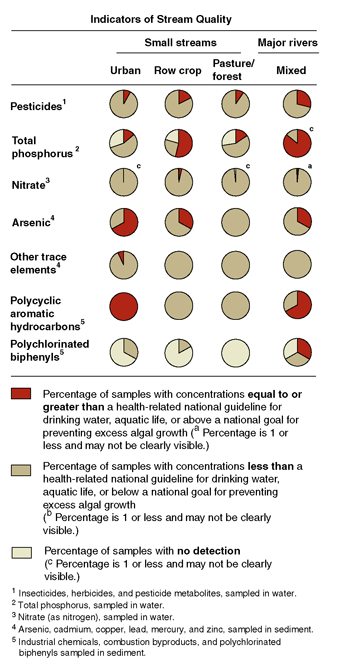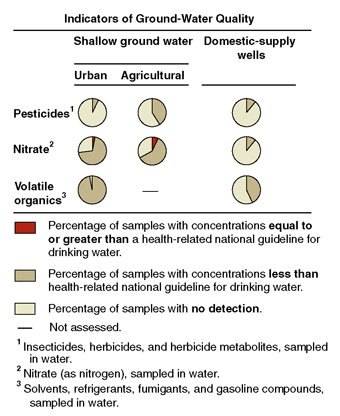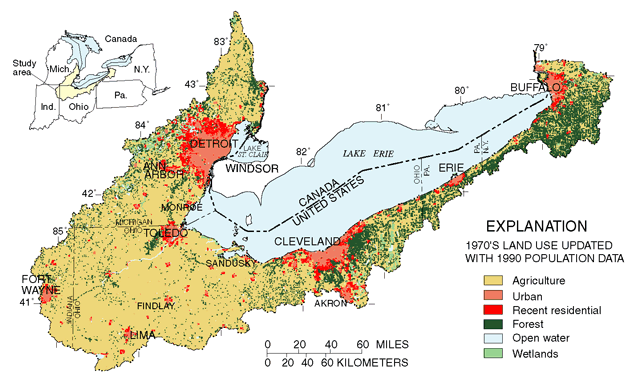SUMMARY OF MAJOR FINDINGS
| Land use in the Lake Erie-Lake Saint Claire Drainage was predominatly agricultural and urban. This level of human activity has substantial effects on water quality in the regional. |
Water quality in the Lake Erie-Lake Saint Clair Drainages is greatly influenced by land use and human activities. A major pathway for contaminant transfer from the land surface to streams is storm runoff from urban and agricultural areas.
As a result of herbicides in runoff, concentrations in streams were in the top 25 percent of streams nationwide and many public-water supplies must treat stream water to reduce herbicide concentrations. As a result of nutrients in runoff, concentrations of total phosphorus and nitrate in some small streams in agricultural areas and in major rivers were in the top 25 percent of streams nationwide. Concentrations of nitrate, although elevated relative to many other streams in the Nation, were infrequently greater than the drinking-water standard of 10 milligrams per liter.
 |
- Contamination of the bed sediments of small streams and major rivers by persistent and bioaccumulative contaminants was prevalent. The highest concentrations of PCBs (polychlorinated biphenyls) and mercury were detected in streams draining highly populated urban and mixed land-use areas. Detections of contaminants in fish tissues indicate bioaccumulation; in fact, bioaccumulation of PCBs and DDT in some fish species presents a health risk to fish-eating wildlife.
- The pesticides detected most frequently were among those applied in the greatest quantities to agricultural and mixed land-use areas. The herbicides atrazine, acetochlor, cyanazine, metolachlor, and simazine were detected in 50 to 100 percent of samples. (p. 6)
- Several heavily used herbicides and insecticides were detected in spring and summer at or above a standard for drinking water or a guideline for aquatic life. Elevated pesticide concentrations in streams persisted for 4 to 6 weeks after applications in agricultural and mixed-land-use areas. (p. 8)
- Annual average concentrations of total phosphorus were greater than the U.S. Environmental Protection Agency recommended level for control of nutrient enrichment at 8 of 10 sites sampled in small streams and major rivers draining agricultural and mixed-use land. Streams draining row-crops and mixed-use land are major pathways of phosphorus to Lake Erie. (p. 10)
- Contaminants detected most often in the bed sediments of small streams and major rivers were arsenic, cadmium, copper, lead, mercury, zinc, PCBs, and PAHs (polycyclic aromatic hydrocarbons). The concentrations of arsenic, mercury, PCBs, and PAHs were equal to or greater than sediment guidelines, indicating probable adverse effects on aquatic life, in about 11 to 30 percent of samples. (p. 13)
- The most frequently detected contaminants in fish were highly persistent contaminants—DDT, chlordane, dieldrin, PCBs, and mercury. Except for mercury, use of these compounds in industry and agriculture in the United States was discontinued 15 to 25 years ago. (p. 14)
- Agricultural land use appears to be affecting fish communities in streams draining areas of row-crops. As the amount of row-crops increased relative to forested land, the number of pollution-intolerant fish species decreased. It appears that pollution-intolerant fish can live where agriculture is the primary land use when streams are protected by natural cover. (p. 17)
| Major Influences on Surface-Water Quality and Aquatic Biota
|
Trends in Surface-Water Quality
Suspended-sediment discharges from the Maumee River Basin decreased by 11.2 percent over the period 1970–98 and corresponded to increased use of conservation tillage to control soil erosion.
The glacial aquifer is the major source of drinking water in the northwestern part of the study area. In this area, ground-water quality is affected by a combination of human and natural factors. Land use determines which chemicals are used; how readily these chemicals are transported to the ground water is affected by geology.
-
In residential areas underlain by sand and gravel, more than 75 percent of ground water recharged since 1953 shows evidence of human activities in the form of nitrate, chloride, or volatile organic compounds (VOCs). Probable sources are (1) septic systems containing human waste and household chemicals, (2) road salt and gasoline residue from paved surfaces, (3) waste from water softeners, or (4) lawn fertilizer. Pesticides were rarely detected. (p. 18)
- In the agricultural study area, which is underlain by till, nitrate and herbicides were detected less frequently than in most other agricultural areas of the Nation. This observation partially supports the belief that till or tile drains protect the aquifer from contamination. Nevertheless, the ground water is still vulnerable to contamination; almost 60 percent of shallow ground water contained herbicides or elevated concentrations of nitrate. Herbicides were predominantly detected as breakdown products. (p. 20)
- In residential and agricultural areas, samples from
domestic wells met health-related drinking-water standards. However,
ground water affected by human activities was detected at depths below
25 feet, the minimum required depth for wells in Ohio and Michigan.
(p. 19)
| Major Influences on Ground-Water Quality
|
Trends in Ground-Water Quality
A significant change in ground-water quality is linked to recent residential development near Detroit. Ground water recharged before 1953 (which predates suburbanization) has concentrations of chemical constituents typical of natural water. In contrast, ground water recharged after 1953 has significantly higher concentrations of constituents derived from human activities.
| Table of Contents || Previous Section || Next Section || Glossary U.S. Geological Survey Circular 1203 Suggested citation:
|


